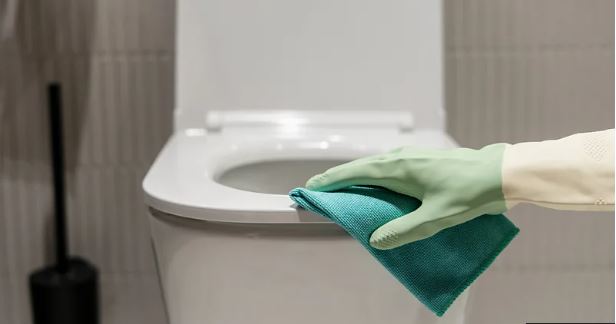
As you sink down onto a toilet seat used by hundreds of other people the same day, you might be wondering: how long do pathogens survive in bathrooms?
Once you set foot in a public toilet, it can be impossible to resist the overwhelming feeling of "ick".
The sight of urine splattered on the toilet seat and the floor, the pungent scent of somebody else's bodily fluids – it can really slam against your senses.
You might open the stall door with your elbow, flush with your foot, or drape the entire seat in toilet paper and execute a squat if you find the whole thing too gross to contemplate.
But can you actually catch diseases from merely sitting on the seat? Or are the elaborate techniques some people use to avoid contact completely unnecessary? Here's what microbiologists have to say.
What you (probably) won't catch
"Theoretically, yes [you can catch diseases from the toilet seat], but the risk is vanishingly low," says Jill Roberts, a professor of public health and microbiology at the University of South Florida.
Take sexually transmitted diseases (STDs). Most of the bacteria and viruses that can cause them, from gonorrhea to chlamydia, cannot survive for long outside of an organism's body, let alone on a cold, hard surface like a toilet seat.
That's why it's thought that the majority of STDs an only be transmitted via direct contact of the genitalia and exchange of bodily fluids.
One would have to be unlucky enough to transfer someone else's fresh bodily fluids immediately from the seat to the genitalia either by hand or toilet paper to be at risk, says Roberts.
So, while it's good to be cautious and maintain hygienic practices, such as avoiding toilets that are obviously contaminated, it's not something that should keep you up at night.
"If toilet seats could [easily] transfer STDs, we would see them frequently across all age groups and in people with no history of sexual activity," says Roberts.
Similarly, Roberts says you're unlikely to catch a bloodborne disease from a toilet seat either. For a start, she thinks you'd see – and avoid – somebody's blood if it was on the toilet seat. In any case, it would not easily transmit bloodborne pathogens in the absence of sexual activity or injection with contaminated needles, she says.
It's equally unlikely that you would catch another person's urinary tract infection (UTI) from the toilet seat, says Roberts.
You'd only get a UTI if you transmitted faeces from the toilet seat to the urinary tract, but a large amount of faeces would be required for this, says Roberts.
It's much more likely that you develop a UTI by wiping your own excrement too close to your genitalia, she adds.
What you can get
There are some exceptions of longer-lived sexually transmitted diseases, though. Human papilloma viruses (HPV), which cause genital warts, can stick around for up to a week on surfaces, although it depends on several factors.
"These viruses are very small and have very stable protein shells that give them a longer 'shelf life' in the environment," says Karen Duus, a professor of microbiology and immunology at Touro University in Nevada.
HPV tends to be resistant to hand sanitisers and requires a concentration of 10% bleach to destroy that tough, protective protein shell, says Duus.
Still, these viruses can only make their way into your body if the skin barrier of your genital area is compromised, says Duus, with a rash or a wound, while you're sitting on the toilet. As such, HPV is typically only transmitted via sexual skin-to-skin contact, such as oral, anal, and vaginal sex.
Similarly, in theory, someone with genital herpes who is having a flare-up could shed virus onto a toilet seat, and subsequent users might be at risk if they have broken skin or if they're immunosuppressed, says Daniel Atkinson, a clinical lead for the online healthcare service company Treated.com in the United States. But it's unlikely, says Atkinson.
So, should I cover the toilet seat, or squat so I don't touch it?
Draping the toilet seat with paper before sitting on it, or using a toilet-seat cover, might feel like the cleanest way to use a public toilet.
However, a layer of toilet paper or a toilet cover will likely not protect you from pathogens – they are made of porous materials, so they cannot stop germs from seeping through and touching your genitals. And squatting could potentially do more harm than good, according to Stephanie Bobinger, a clinical specialist in pelvic health at The Ohio State University Wexner Medical Center.
When women hover over the toilet to urinate, they contract the pelvic floor and pelvic girdle muscles. This obstructs the flow of urine from the bladder, making it necessary to push harder and exert unnecessary strain on the pelvis. It also means that women might not empty their entire bladder in the process, which can sometimes even lead to a urinary tract infection.
The actual problem
As it happens, the risk of catching diseases in the bathroom, in general, doesn't come from your genital contact with the toilet seat.
One study calculated that people are most likely to become infected with norovirus by touching contaminated surfaces in a bathroom, compared to Covid-19 and adenovirus – a pathogen which leads to cold or flu-like symptoms in most infected people, or more severe illness in those who are elderly or immunocompromised.
Still, the actual risk of getting sick this way might be low. "The bathroom isn't contaminated with faeces from the dark ages – it is cleaned regularly," says Roberts. She says that when her microbiology students swab the surfaces of different environments for microbes, the amount they find in the computer lab is unspeakable in comparison to that of toilet stalls.
"In the United States, home restrooms are far germier than public restrooms that we studied at a university," says Charles Gerba, a professor of virology at the University of Arizona. "It's [arguably] safer to use a toilet in the public restroom than at home in most places."
In most locations, cleaning crews wipe down public toilets several times a day, while most households only clean their bathroom once a week, say Gerba's surveys. The ideal cleaning schedule for household bathrooms, according to Gerba's laboratory, should be every three days.
Beware the 'toilet sneeze'
Of course, most people aren't going around caressing the toilet seats of bathrooms. And though most people wash their hands much less often than we'd like to think (Read more from the BBC about why some people don't wash their hands), hopefully you don't usually put your hands in your mouth after using the toilet. However, there is another way of contracting a disease in the bathroom.
Enter the toilet plume. When you flush the toilet, the germs inside the bowl are propelled into the air and land all over the bathroom stall. And all over you, if you're still in the stall.
Mathematical models suggest that 40-60% of the particles present in a toilet bowl might travel. "Some people like to call it the 'toilet sneeze'," says Gerba.
Studies have found and the bacteria Clostridium difficile – a pathogen that's common in healthcare settings and can be notoriously difficult to eradicate from the environment – can travel far and wide in the air after the toilet has been flushed. The he latter travels in spores and can be inhaled too
This risk, therefore, is not just from toilet seats, but from toilet lids, doorknobs, toilet flushes, sink handles, and towel dispensers, which you touch directly with your hands, says Gerba. The "germiest" surface, he says, is actually the floor.
Unfortunately, bathrooms also often have traces of bonus pathogens that you wouldn't necessarily associate with one's urine or poo, but simply with sneezing and coughing. For example, the flu virus can sometimes be found on bathroom surfaces.
How to avoid diseases when you're in the toilet
There are several common-sense steps you can take to avoid contracting something nasty from any toilet facility, whether at home or in public. Elizabeth Paddy, a water hygiene engineer at Loughborough University in the UK, recommends touching things as little as possible. (In fact, one way toilet manufacturers could make bathrooms safer is by designing touchless flushing mechanisms, soap dispensers, hand dryers, and more, says Paddy.)
To avoid toilet plumes, closing the lid to flush might seem like a responsible choice, but "closing the lid and opening it didn't make much difference in that at all", says Gerba. His 2024 study suggests that viruses in toilet plumes can escape sideways, even when the lid is down. That's likely because lids don't tend to be perfect fits with toilet seats, and public toilets tend to have higher-pressure flushes to consume less water.
In fact, Paddy thinks that bathroom manufacturers should remove lids from toilets altogether, to avoid people touching the lid and then accidentally touching the toilet seat too. "The lid is not really the way forward," she says.
There are more effective interventions, says Paddy, like making toilet bowls with shields that go between the bowl and the seat. Currently, these are largely used in healthcare settings to protect nurses and doctors from patients' flushed pathogens, says Paddy. There are also air sprays that have been demonstrated to be effective in sanitising the air and surfaces in bathrooms, therefore helping to counteract the dissemination of pathogens via toilet "sneezes".
Another option is to just flush and then leave the stall immediately. "I usually do the flush and run," says Gerba. He also recommends waiting 10 minutes before going into a public toilet after somebody else, though that might be tricky to achieve in practice.
Then there are mobile phones. It's not recommended to use your phone while in the toilet stall, says Roberts – your phone is already exceptionally dirty, as you take it with you everywhere, rest it on every ledge, and touch it all the time. If you bring it to the toilet, you'll risk it touching pathogens that have been sprayed around the stall, and then you'll carry them around with you even after washing your hands.
The simplest thing you can do is to always wash your hands immediately after you go to the bathroom, says Gerba, who notes that the average person in Tucson, Arizona, only spends 11 seconds washing their hands, while the Centers for Disease Control in the United States suggests handwashing for 20 seconds. "Only about one in five actually wash their hands adequately," says Gerba.
So, to prevent catching a disease in the public restroom, wash your hands. Better still, add an extra step of applying hand sanitiser too, as the combination is significantly more protective than handwashing alone. And try not to let the fear of pathogens lurking in toilets keep you up at night – your risk is (probably) lower than you think.















